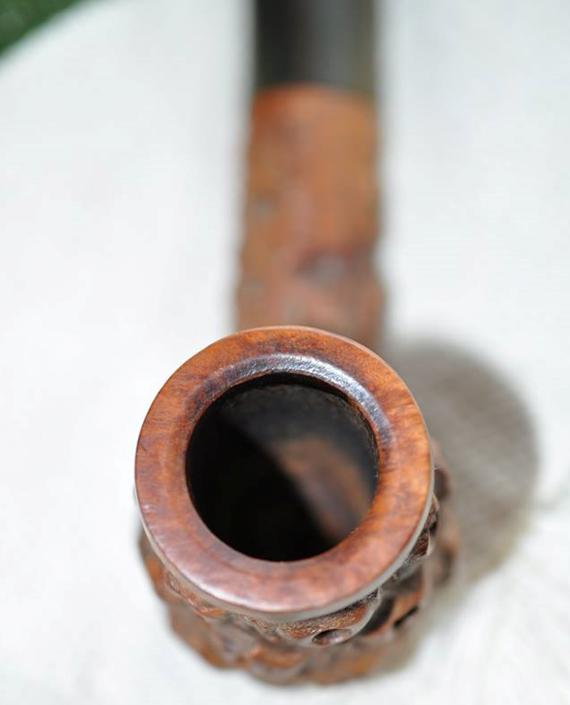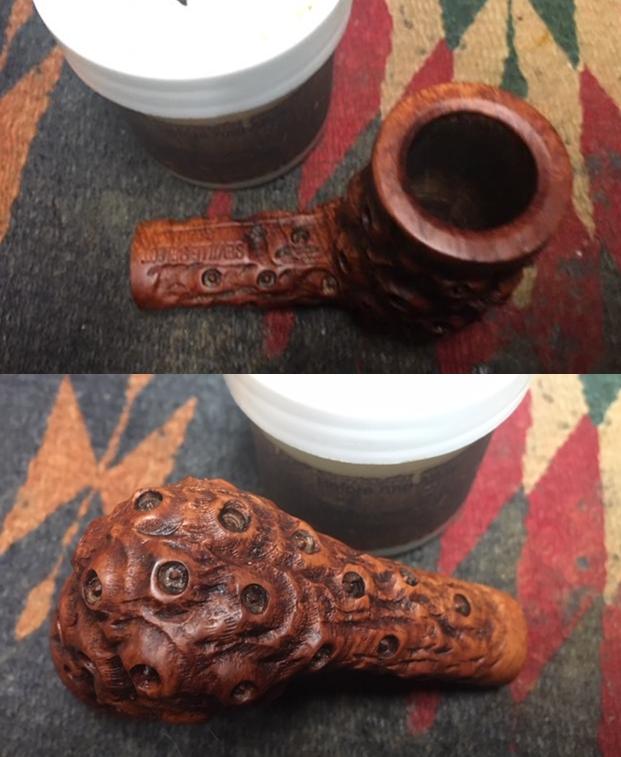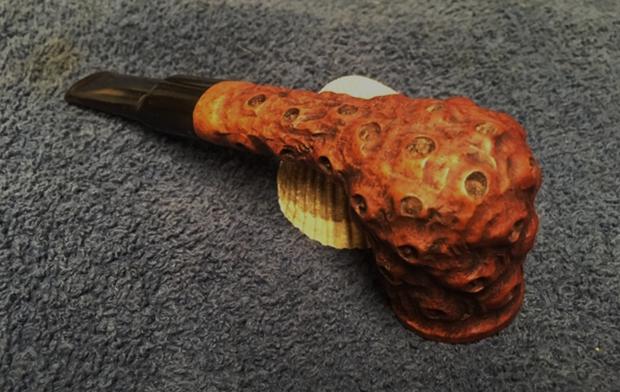Blog by Steve Laug
This is yet another pipe that I don’t remember where Jeff picked it up. It has a shape and finish that I like to work on. The cratered, almost moon surface type of finish on the shank and bowl are unique and I have only seen them on these Spanish made pipes. Other than being dirty and dusty in all of the craters on the finish the pipe was in decent condition. The rim top had a little bit of lava and darkening but nothing serious. There was a light cake in the bowl that would come out fairly easy. The stem was oxidized with light tooth chatter near the button on both sides. The pipe was stamped on the topside of the oval shank in a smooth panel. It was in great condition and I could read Seville Select over Spain. Jeff took photos of the pipe before he started his cleanup process to show the condition it was in when he found it.
 He took photos of the pipe from various angles to show the rustication pattern. It really is a unique rustication that has an easily identifiable look to it that says “Spanish” when I see one.
He took photos of the pipe from various angles to show the rustication pattern. It really is a unique rustication that has an easily identifiable look to it that says “Spanish” when I see one.

 The next photo shows the clear and readable stamping on the top of the shank.
The next photo shows the clear and readable stamping on the top of the shank. The stem photos show a lightly oxidized stem with little damage other than light tooth chatter on both the top and undersides.
The stem photos show a lightly oxidized stem with little damage other than light tooth chatter on both the top and undersides. Jeff had scrubbed the exterior of the bowl with a tooth brush Murphy’s Oil soap to work into the rustication pattern and remove all of the dust and grime that had accumulated in the moon crater style rustication. The finish looked dry and tired but the rustication was in very good condition once it had been scrubbed. The rim top looked very good with some minor darkening remaining on the back inner edge of the bowl. He reamed the bowl with a PipNet reamer and cleaned it up with a Savinelli Fitsall Pipe Knife. He cleaned the interior of the mortise and the airway in the shank and the stem with alcohol, cotton swabs and pipe cleaners. The pipe came to me clean and ready to do the restoration. The cleaning had raised more oxidation on the stem. I took some photos of the pipe to show the condition at this point in the process.
Jeff had scrubbed the exterior of the bowl with a tooth brush Murphy’s Oil soap to work into the rustication pattern and remove all of the dust and grime that had accumulated in the moon crater style rustication. The finish looked dry and tired but the rustication was in very good condition once it had been scrubbed. The rim top looked very good with some minor darkening remaining on the back inner edge of the bowl. He reamed the bowl with a PipNet reamer and cleaned it up with a Savinelli Fitsall Pipe Knife. He cleaned the interior of the mortise and the airway in the shank and the stem with alcohol, cotton swabs and pipe cleaners. The pipe came to me clean and ready to do the restoration. The cleaning had raised more oxidation on the stem. I took some photos of the pipe to show the condition at this point in the process.
 I took some photos of the rim top to show what it looked like when it arrived. It was almost pristine with little darkening on the beveled edge of the rim. I also took close up photos of the stem to show the oxidation. The stem had some light tooth chatter and marks on the surface near the button.
I took some photos of the rim top to show what it looked like when it arrived. It was almost pristine with little darkening on the beveled edge of the rim. I also took close up photos of the stem to show the oxidation. The stem had some light tooth chatter and marks on the surface near the button.  I did not know much about the brand so I did a bit of research on the internet to see if I could ferret out any information. The first spot I turned was the pipephil logos and stampings website (http://www.pipephil.eu/logos/en/logo-s5.html). There I learned to my surprise that the brand was a line of Mastercraft pipes. The stamping on the shank in the photo above looks similar to the second and third stamping photo below.
I did not know much about the brand so I did a bit of research on the internet to see if I could ferret out any information. The first spot I turned was the pipephil logos and stampings website (http://www.pipephil.eu/logos/en/logo-s5.html). There I learned to my surprise that the brand was a line of Mastercraft pipes. The stamping on the shank in the photo above looks similar to the second and third stamping photo below. I turned to the next site I generally turn to for information – Pipedia to see if there was additional information (https://pipedia.org/wiki/Mastercraft).
I turned to the next site I generally turn to for information – Pipedia to see if there was additional information (https://pipedia.org/wiki/Mastercraft).
It doesn’t appear it was ever a manufacturer and bought pipes from multiple factories — mostly French and English. It survived briefly the post war recovery and then was acquired by Grabow…
United States Tobacco (UST) (Skoal and Copenhagen) bought Grabow in 69′ from the Lavietes family. In 74′ they bought M/C from Bernard Hochstein and moved it into the EXACT facility Grabow occupied. I was named “operations manager” and we were in the basement of a 4 story building in Sparta, NC…
M/C was STRICTLY an importer of pipes and pipe related merchandise. In 74′ when M/C moved from NYC to NC the inventory of finished goods was stored in a facility in Winston Salem, NC. Lentz Moving and Storage. Stacked 10 feet high the inventory covered 180,000 square feet….FINISHED…
I’ll just list a few Manufacturers/names of their inventory. England…Parker/Hardcastle (Dunhll), Orlik. France…Jeantet, Jima, Cherrywoods. Italy…GIGI pipe, Radici, Rossi, Federico Rovera, Santambrogio, Brebbia. Meerschaums from Austria….Strambach. Lighters from Japan….Pouches and accessories from Hong Kong…and the Israeli pipes from Mr. Hochstein’s sons. Trust me…This is only a small sample of the things M/C had, and bought into inventory.
Now the connection. Since M/C and Grabow shared a building, and I was an employee of Grabow we compared notes. Grabow copied a BUNCH of M/C items fully with my help and some skills I had developed…
Now the other way. Grabow to Mastercraft. M/C never really had a source of continuing supply. The foreign manufacturers would make a line for a while and then quit. Never do it again, no matter how well it sold, no matter the demands we put on em’. Grabow gave M/C a source of stability, and a nice profit for both companies. A lot of these you will not have heard of, but maybe….Seville, for M/C all smooth, for Grabow all rustic Hillcrest…. Freehand, For M/C Andersen and (a few Mastersen), for Grabow, Freehand with a DRB tampon. New finishes…New shapes, New bits…..Mastercraft showed Grabow how to use LUCITE for stems… Royalton. Again these are just examples.
I back sourced the above information to the Dr. Grabow group on Tapatalk where Ted who contributed the above information to Pipedia answered a question about the Seville Line of pipes (https://www.tapatalk.com/groups/drgrabows/is-seville-grabow-t5171.html).
Ted is the expert on this…because of the fact that Seville pipes were distributed by Mastercraft during Ted’s tenure there. Mastercraft shared the same building with Grabow in Sparta…and Ted has about a million very interesting stories and recollections from his days there.
Quoting Ted from an earlier post: “Mastercraft started importing Seville from GIGI PIPE in Varese in the late 70’s or early 80’s. The Seville became one of the most popular pipes M/C sold. They came in several versions, Regular, Filter, Convertible, and Lucite. They were so popular that Grabow started making some for M/C. This gave M/C a steady source of supply, and allowed Grabow to make some fancier shapes for their regular lines. I think Grabow was making most all of them by the mid 80’s.”
I believe the Sparta-made Sevilles would NOT say ‘Italy’ on them…as those stamped Italy would have been made by GIGI. Ted can verify that. Ted has also confirmed that a few of the Seville shapes were added to the Hillcrest line. A couple are very close, and 2 or 3 are identical, from what I’ve seen.
I have learned from my internet excursion that the pipe was most likely made in Spain by a pipe maker there. The brand later became a sub-brand or line from the Grabow factory. It is interesting to note in all of the above there is no identification of the pipe maker in Spain and no mention of the brand being made in Spain… ah well yet another mystery of pipe repair and refurbishing.
I started my restoration of this pipe by rubbing the bowl down with Before & After Restoration Balm to deep clean the briar bowl and the rim top as well as the briar shank. The product works to clean, enliven and protect the briar. I hand rubbed it with my fingers, working it into the exterior of the pipe. I worked it into the rusticated surface of the briar with a horsehair shoe brush. After it had been sitting for a little while, I buffed it with a soft cloth to polish it. The pipe really began to have a rich shine. I took some photos of the bowl at this point to mark the progress in the restoration.
 I applied some Conservator’s Wax and worked it into the surface of the rustication with my fingertips. I worked it over with a horsehair shoebrush to further get it into the pits and buff it to a shine. I buffed it with a microfibre cloth to deepen the shine.
I applied some Conservator’s Wax and worked it into the surface of the rustication with my fingertips. I worked it over with a horsehair shoebrush to further get it into the pits and buff it to a shine. I buffed it with a microfibre cloth to deepen the shine.
 I had removed the stem when I was working on other pipes and put it, along with two other stems to soak in a Before & After Deoxidizer bath. I left them in the bath for about 4 hours to soak and break through the oxidation. I took the stems out of the bath and rinsed them under running water and scrubbed them dry with a coarse piece of cloth. I took photos of the three stems before I continued my work.
I had removed the stem when I was working on other pipes and put it, along with two other stems to soak in a Before & After Deoxidizer bath. I left them in the bath for about 4 hours to soak and break through the oxidation. I took the stems out of the bath and rinsed them under running water and scrubbed them dry with a coarse piece of cloth. I took photos of the three stems before I continued my work.
 I broke up the residual oxidation on the stem surface with 220 grit sandpaper. I worked on it until all the oxidation and the light tooth chatter was removed.
I broke up the residual oxidation on the stem surface with 220 grit sandpaper. I worked on it until all the oxidation and the light tooth chatter was removed. I polished the stem with micromesh sanding pads – wet sanding with 1500-2400 grit pads and dry sanding with 3200-12000 grit sanding pads. I wiped the stem down with Obsidian Oil after each pad. I polished it with Before & After Pipe Polish – both Fine and Extra Fine and gave it a final coat of Obsidian Oil. I set the stem aside to dry.
I polished the stem with micromesh sanding pads – wet sanding with 1500-2400 grit pads and dry sanding with 3200-12000 grit sanding pads. I wiped the stem down with Obsidian Oil after each pad. I polished it with Before & After Pipe Polish – both Fine and Extra Fine and gave it a final coat of Obsidian Oil. I set the stem aside to dry.


 I polished stem and the bowl with Blue Diamond polish on the buffing wheel. I gave the bowl multiple coats of Conservator’s Wax and the stem multiple coats of carnauba wax. I buffed the pipe with a clean buffing pad to raise the shine. I hand buffed it with a microfiber cloth to deepen the shine. The pipe polished up pretty nicely. The rustication came alive with the buffing and worked well with the polished black vulcanite stem. Together the pipe looks much better than when I began and has a rich look. The finished pipe is shown in the photos below. The shape, finish and flow of this Spanish Made pipe and stem are very well done. The dimensions are Length: 5 1/4 inches, Height: 1 3/4 inches, Outside diameter of the bowl: 1 3/16 inches, Chamber diameter: 3/4 of an inch. I will be adding this interesting Seville Select Spanish made pipe to the rebornpipes store shortly if you are interested in adding it to your collection and carrying on the trust. Thanks for walking through the restoration with me as I worked over yet another unique and interesting old pipe. I really like the look and feel of this finish.
I polished stem and the bowl with Blue Diamond polish on the buffing wheel. I gave the bowl multiple coats of Conservator’s Wax and the stem multiple coats of carnauba wax. I buffed the pipe with a clean buffing pad to raise the shine. I hand buffed it with a microfiber cloth to deepen the shine. The pipe polished up pretty nicely. The rustication came alive with the buffing and worked well with the polished black vulcanite stem. Together the pipe looks much better than when I began and has a rich look. The finished pipe is shown in the photos below. The shape, finish and flow of this Spanish Made pipe and stem are very well done. The dimensions are Length: 5 1/4 inches, Height: 1 3/4 inches, Outside diameter of the bowl: 1 3/16 inches, Chamber diameter: 3/4 of an inch. I will be adding this interesting Seville Select Spanish made pipe to the rebornpipes store shortly if you are interested in adding it to your collection and carrying on the trust. Thanks for walking through the restoration with me as I worked over yet another unique and interesting old pipe. I really like the look and feel of this finish.












